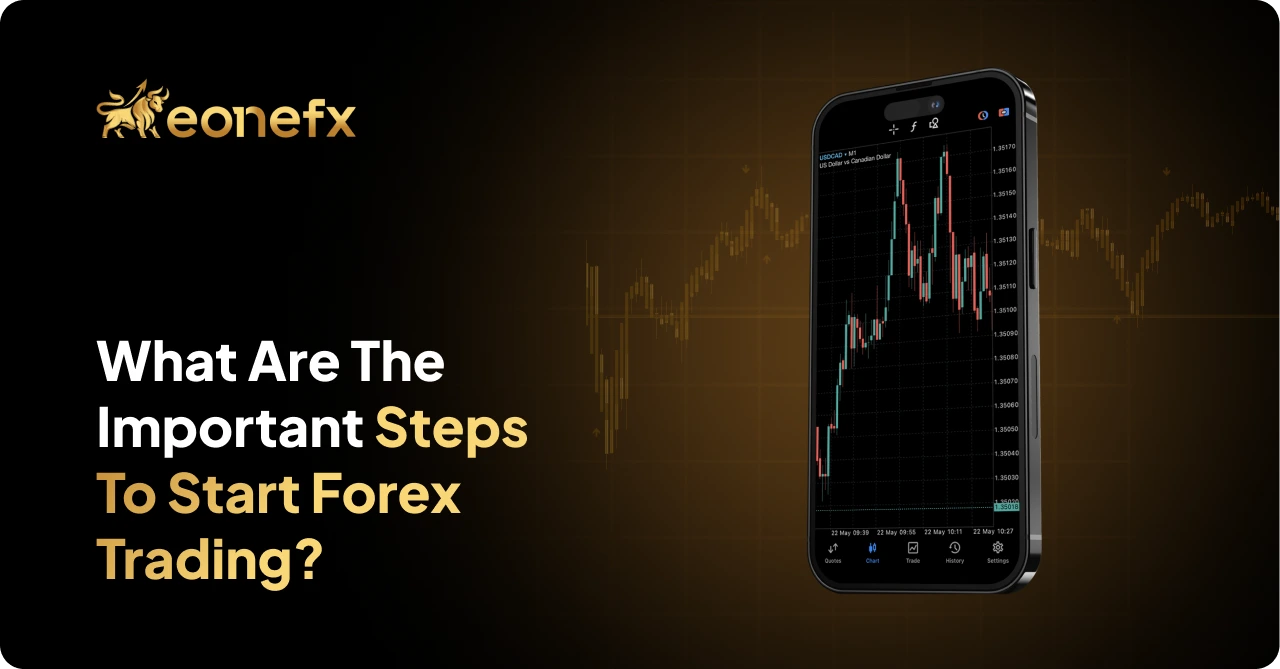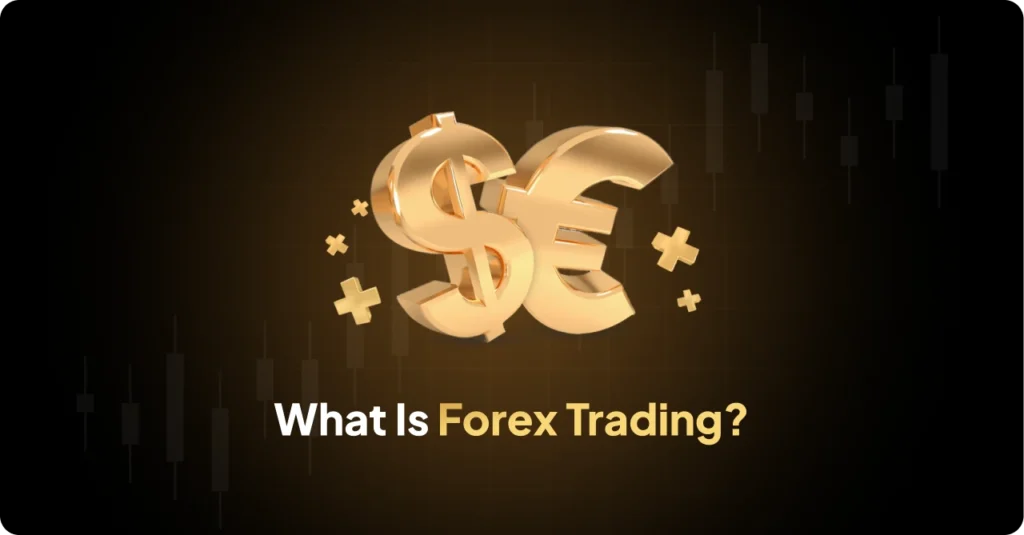What are the important steps to start forex trading?
By EoneFX Insights
30 December 2024

Picture this: You’re at the crossroads of financial opportunities, staring at the vast and fast-paced world of forex trading. A market where $7.5 trillion exchanges hands every day, forex trading offers endless possibilities—but also demands a calculated and informed approach.
In this guide, we’ll explore the crucial steps to start your forex trading journey, blending knowledge from experienced traders and actionable insights to ensure your first trades are both confident and informed.
What Is Forex Trading?
Forex trading, or foreign exchange trading, involves buying and selling currency pairs to profit from fluctuations in exchange rates. It’s the backbone of the global financial system, facilitating international trade and investments.

Key Points to Know About Forex Trading
1. Decentralized Market
Unlike stock markets, the forex market operates without a central exchange. It’s a network of banks, brokers, and traders connected globally..
2. Market Hours
The forex market operates 24/5, opening in Sydney, followed by Tokyo, London, and New York, allowing traders to participate in different time zones.
3. Trading Volume
With a daily trading volume exceeding $7.5 trillion (Source: BIS 2022), forex is the most liquid market globally, offering ample opportunities for all traders.
4. Common Currencies
Popular currency pairs include EUR/USD, USD/JPY, and GBP/USD, which account for a significant portion of daily trades due to their liquidity and stability.
Forex Trading Serves a Few Purposes
1. Profit
Most traders engage in forex to speculate and earn profits from short-term price movements.
2. Hedging
Businesses and investors use forex trading to hedge against unfavorable currency fluctuations, protecting their assets and liabilities.
Types of Forex Markets
Forex trading is versatile, offering several market types to suit different trading needs:
- Spot Market: The spot market involves immediate currency transactions at current exchange rates. It’s the most straightforward and commonly used market for forex trading.
- Forward Market: In the forward market, contracts are made to buy or sell currencies at a specified future date, protecting traders from price volatility.
- Futures Market: Similar to the forward market, but contracts are standardized and traded on centralized exchanges, offering more liquidity and transparency.
- Options Market: Options allow traders the right—but not the obligation—to buy or sell currencies at a set price before a specific date.
How to Trade Forex as a Beginner: A Step-by-Step Guide
Starting your forex trading journey may seem daunting, but breaking it down into actionable steps makes it manageable.
1. Choose a Reliable Forex Broker
Selecting a broker with strong regulatory compliance, competitive spreads, and a robust trading platform is essential. Look for brokers with licenses from authorities like the FSC (Mauritius) or ESMA.
2. Open and Set Up Your Trading Account
Create an account with your chosen broker, providing identification and proof of address. Start with a demo account to familiarize yourself with trading tools.
3. Learn Forex Basics
Educate yourself on key forex concepts, such as pips, leverage, and margin, to make informed decisions.
4. Develop a Trading Plan
Define your goals, risk tolerance, and strategies. A solid plan helps you stay disciplined and navigate market volatility effectively.
5. Choose Your Currency Pairs
Select currency pairs that align with your strategy and risk appetite. For beginners, major pairs like EUR/USD are ideal due to their liquidity.
6. Perform Market Analysis
Use technical and fundamental analysis to assess market trends. Tools like moving averages, economic calendars, and candlestick patterns can provide valuable insights.
7. Execute Your Trades
Place buy or sell orders based on your analysis. Set stop-loss and take-profit levels to manage risk and secure profits.
8. Monitor Your Trades
Track your open positions and adjust your strategy as needed based on market movements.
9. Learn From Your Trades
Review your trading history to identify what worked and what didn’t, continuously refining your approach.
How Much Do You Need to Start Forex Trading?
The capital required varies depending on your broker and goals. Many brokers allow you to start with as little as $50, but starting with a larger amount, such as $500–$1,000, offers more flexibility and minimizes the impact of transaction costs.
Basic Forex Trading Strategies for Beginners
Having a well-defined forex traing strategy is crucial for success. Here are six beginner-friendly strategies:
- Trend Trading: Follow market trends to capitalize on consistent price movements. Tools like moving averages and trendlines can help identify trends.
- Range Trading : Focus on trading within a defined price range, buying at support levels and selling at resistance levels.
- Breakout Trading : Trade on price movements that break out of a defined range, often signaling the start of a new trend.
- Scalping : Engage in multiple small trades to profit from minor price movements. Scalping requires fast execution and low spreads.
- Swing Trading : Hold positions for days or weeks to profit from medium-term price swings.
- Position Trading : Adopt a long-term approach, holding positions for months or years based on macroeconomic trends.
Risks of Forex Trading
While forex trading offers opportunities, it also comes with risks that traders must manage effectively.
- Market Volatility: Price fluctuations can lead to significant gains or losses. Monitoring trends and using stop-loss orders can mitigate this risk.
- Leverage: Leverage amplifies both profits and losses. Traders should use leverage cautiously, starting with lower ratios.
- Counterparty Risk: The risk of broker default can be minimized by choosing a regulated and reputable broker.
- Interest Rates: Currency values are influenced by central bank policies and interest rate decisions.
- Liquidity Risks: Certain currency pairs may lack liquidity, leading to slippage during execution.
- Psychological Risks: Fear and greed can impact decision-making. Sticking to your trading plan helps maintain discipline.
- Regulatory Risks: Unregulated brokers pose risks. Always trade with licensed and transparent brokers.
- Macroeconomic and Geopolitical Risks: Events like elections, wars, and natural disasters can significantly impact currency prices.
Conclusion: Starting Forex Trading on the Right Steps
Starting forex trading requires careful planning, education, and the right tools. By understanding the market, choosing a reliable broker, and adopting proven strategies, you can navigate the complexities of forex trading with confidence. Begin your journey with EoneFX, a trusted broker offering comprehensive resources and support for traders worldwide.
FAQs
1. What is the best forex trading strategy for beginners?
Trend trading is ideal for beginners due to its simplicity and reliance on market movements.
2. How much money do I need to start forex trading?
You can start with as little as $50, but a larger capital base offers more flexibility.
3. Is forex trading safe in the UAE?
The best Forex broker offers a user-friendly platform, low trading costs, and robust educational resources. Eonefx checks all these boxes.
4. Can I practice forex trading without risking real money?
Yes, demo accounts allow you to practice trading with virtual funds.
5. What tools are essential for forex trading?
Trading platforms like MetaTrader 4/5, economic calendars, and technical indicators are essential.
6. Why is leverage risky in forex trading?
Leverage magnifies both potential profits and losses, making risk management crucial.
This blog is designed to provide comprehensive insights into starting forex trading, helping readers make informed decisions and embark on their trading journey confidently. Let me know if you need further adjustments or additions!


